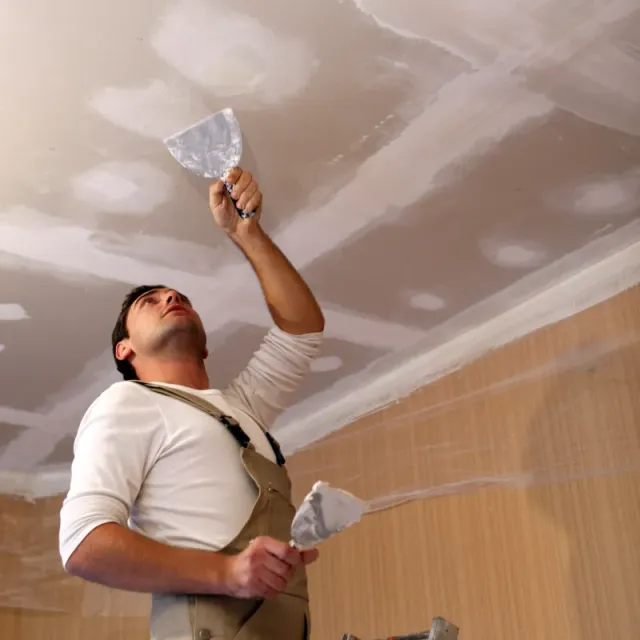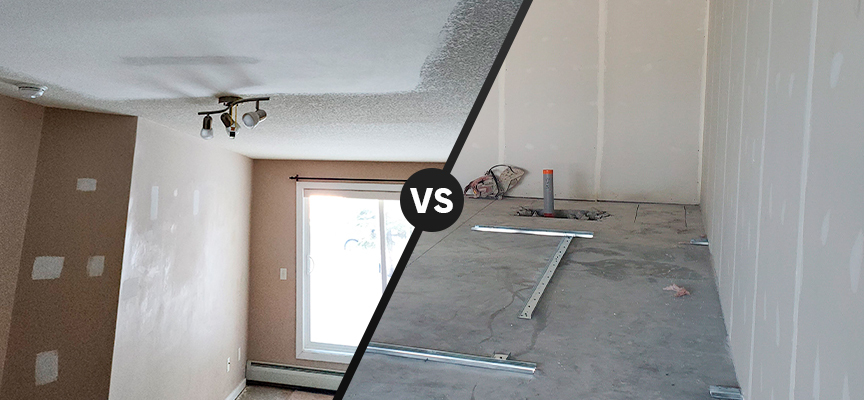Discover the very best Practices for Effective Drywall Repair Service and Installation
The art of drywall repair work and setup requires a blend of ability and precision. Mastering the vital devices is crucial for accomplishing a seamless surface. Recognizing the step-by-step procedure can make a substantial difference in the result. Correct strategies for mudding and taping are likewise essential. What remains is the understanding of maintenance that assures longevity. These components together create a sleek outcome worth discovering even more.

Crucial Tools for Drywall Repair and Installment
When undertaking drywall repair work and setup, having the right devices can significantly improve the performance and top quality of the work. An utility blade is crucial for cutting drywall sheets specifically, while a drywall saw can assist in making extra detailed cuts. Taping knives, readily available in various sizes, are crucial for using joint substance efficiently and equally. A drywall sander, preferably with a dirt collection feature, assists attain a polished finish, minimizing the demand for comprehensive clean-up.
Furthermore, a determining tape assurances exact measurements, and a degree guarantees that installations are straight and plumb. Safety and security equipment, consisting of dust masks and safety glasses, ought to not be neglected to secure versus debris and dirt. Ultimately, a stud finder aids in situating framing participants, assuring safe setup. By furnishing oneself with these vital devices, the repair and installment process comes to be a lot more convenient and leads to a professional-quality outcome.

Step-by-Step Guide to Patching Holes
Patching holes in drywall requires a systematic method to assure a seamless repair service. The location around the hole need to be cleaned and any type of loose debris got rid of. For tiny holes, a putty blade can be utilized to apply a lightweight spackle, pressing it right into the opening and smoothing the surface area. After it dries, fining sand is necessary to produce a flat coating. For larger holes, a spot of drywall may be necessary. This entails reducing a piece of drywall somewhat larger than the hole, protecting it to the wall with screws, and utilizing joint compound to cover the seams. When the substance dries, it needs to be fined sand smooth. Lastly, priming the patched area before painting will assure an also surface. Following these actions will lead to a professional-looking repair work that mixes perfectly with the surrounding wall surface.
Techniques for Smooth Drywall Setup
Attaining seamless drywall installation needs careful planning and execution. It is crucial to gauge and reduce drywall sheets accurately to decrease gaps. Making use of an utility knife, installers ought to score the board prior to snapping it along the cut line, making sure tidy sides. Effectively aligning the sheets is important; starting from the leading and functioning down assists preserve uniformity.
Securing drywall to the studs calls for regular spacing, typically every 16 inches, making use of screws as opposed to nails for much better hold. This strategy click to investigate minimizes the danger of stands out in time. Furthermore, staggering the seams between sheets improves architectural honesty and lowers the exposure of joints.
Using the ideal density of drywall for certain areas-- such as moisture-resistant types in washrooms-- additional contributes to a perfect surface. Adhering to these methods will lead to a professional-looking and smooth installment, establishing the stage for the subsequent finishing processes.
Completing Touches: Taping and Mudding
Finishing touches, such as taping and mudding, play a crucial duty in attaining a refined drywall surface. Taping entails applying a slim strip of drywall tape over the joints and joints, guaranteeing a seamless appearance. This process helps prevent fractures and develops a strong bond in between drywall sheets. It is crucial to choose the ideal sort of tape, with paper and fiberglass harmonize being one of the most usual options.
Mudding, or applying joint substance, follows taping. This substance fills out spaces and ravel the surface for an uniform coating. It is typically used in numerous layers, with each coat needing to dry prior to sanding. Proper technique involves feathering the edges to blend the compound right into the bordering drywall, reducing visibility.
When finished appropriately, mudding and taping boost both the architectural and visual integrity of the drywall installment, causing a professional-quality surface.
Tips for Preserving Your Drywall After Installment
:max_bytes(150000):strip_icc()/SPR-solutions-to-common-drywall-problems-p2-4120949-hero-c15a37669eae45478eca0cf15b34a1d1.jpg)
In addition, keeping a regular interior humidity degree can avoid bending or mold and mildew growth. Utilizing a dehumidifier in damp locations, like cellars, is a good idea. It's also helpful to regularly repaint areas that reveal wear, as this protects the underlying material. Lastly, when relocating furniture or mounting components, caution should be exercised to prevent damaging the drywall. By following these upkeep suggestions, homeowners can expand the life of their drywall, guarding it stays an appealing attribute of their insides.
Regularly Asked Questions
What Safety Equipment Is Necessary for Drywall Repair and Installation?
For drywall fixing and setup, important security gear includes safety goggles to protect eyes, dirt masks to stop breathing of fragments, gloves for hand security, and knee pads for convenience throughout prolonged kneeling. drywall contractor.
Just how Do I Establish the Drywall Thickness Needed for My Project?
To identify the drywall thickness required for a job, one need to think about the wall's structural demands, regional building codes, and the intended use the space, usually choosing 1/2-inch or 5/8-inch drywall.
Can I Repair Drywall Without Removing Furniture From the Space?
Yes, drywall can be fixed without removing furnishings from the room. Careful planning and protective measures can reduce mess, permitting for effective repair services while maintaining surrounding items risk-free from dust and damage throughout the procedure.
What Kinds of Drywall Are Best for Various Environments?
Moisture-resistant drywall is optimal for washrooms and cooking areas, while soundproof drywall matches shared walls in apartment or condos. Fire-rated drywall is best for garages, and standard drywall works well in basic living locations, guaranteeing resilience and suitability for numerous environments.
Just how Long Does It Consider Drywall Mud to Dry Totally?
Drywall mud normally takes 24 to 2 days to completely dry totally, depending upon aspects like moisture and temperature (drywall contractors). Thicker click resources applications may require longer drying times, while thinner layers can dry quicker. Appropriate ventilation aids drying out
The art of drywall repair work and installation calls for a mix of ability and accuracy. When carrying out drywall repair service and setup, having the right devices can considerably enhance the performance and quality of the work. An utility knife is necessary for cutting drywall sheets precisely, while a drywall saw can assist in making more detailed cuts. Attaining seamless drywall installation demands careful preparation and execution. Moisture-resistant drywall is ideal for shower rooms and kitchens, while soundproof drywall matches shared wall surfaces in houses.